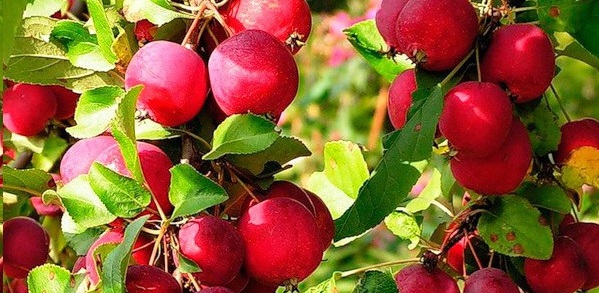None of the gardens in Russia, perhaps, did not do without a ratenka. Modest and inconspicuous, in spring it becomes covered with white, fragrant mist of flowers, in the summer it gives comfort and coolness, and in the fall - fruits. They may not always be big and sweet, but lovers will enjoy them or prepare jam for the winter, there is always.
It seems invisible and unpretentious, growing almost everywhere, so what is special about it? In this article we will talk about Ranetkah apples.
Table of contents
Breeding history
For more than a century, experiments were carried out on crossing wild Siberian apple trees (Siberian) with an apple tree, and its Chinese hybrids (European varieties).As a result, small-fruited varieties of apple trees appeared. They are characterized by the qualities of a Siberian apple tree: they are skoroplodny, winter-hardy, and they produce a stable harvest every year. Due to these important qualities they are often used in breeding when crossed with other varieties. This is the first generation from the previous species with a fetal mass of 15 grams.
To other varieties, it transmits not only winter hardiness, but also small fruits with a tart taste with a sourness. By singing in September, they are universal for processing. Jams, compotes, jam of them are very fragrant and tasty. Best of all, they got accustomed and spread in the Urals, Altai, Krasnoyarsk, Omsk. This is the Siberian assortment of rannet, which is of little interest to Europeans who have sweet and large varieties of apples.
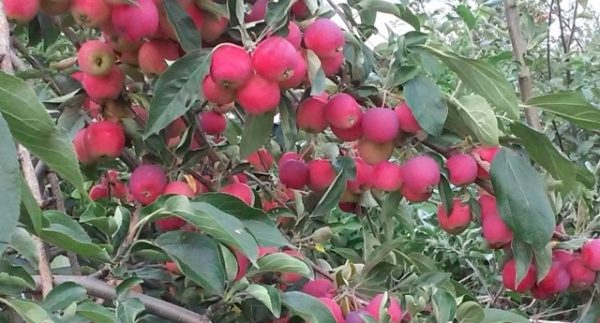
Description of varieties of rannet
Ranetki characterized by the predominance of the qualities of the variety Sibirka and well caught on inour northern regions. Several of these varieties are particularly popular with gardeners.
- Grade Long begins to bear fruit after 4-5 years. Productivity makes about 25 kg from one plant, the mass of a fruit reaches 13 gr. The fruit tastes sour, fragrant and juicy. Color - bright purple. Rip in September, the average performance is average. Apples are good for making compotes and juices. Apple is characterized by average winter hardiness and yield. Sredneroslaya.
- Sort Ranetka red Bred in Blagoveshchensk. Fruits in the second year. The yields are annual and stable, but medium-sized apples weighing 10g. and are used more often for processing. Apple spherical, ribbed. The ripening period is at the end of August. Winter hardiness and durability in this class are average.
- Grade Ranetka Raspberry gives stable, annual yields. Starts to fruition in the second year after landing. The variety is very winter-hardy, but the fruits are small, weighing up to 6 grams. The dense texture of apples allows them to be stored for up to 6 months, but they are mainly used for processing. Ripon en masse, in the first half of September.
- Grade Ranetka Amber known under the name Yantarka Altai.Fruits in the 4th year, the trees are tall, are winter hardiness and durability. Fruit steadily, high yield. Apples are small, weighing 10 grams., The taste is sour and slightly tart. Go for recycling.
- Grade Minusinskoye red skoroploden, high yielding, winter-hardy. Medium height, the shape of the crown is round. The fruit is greenish-yellow, rather large, weighing 15-18g., But fresh. When mixed with sour apples, tasty juices are obtained.
- Siberian variety was launched at the Novosibirsk Experimental Station. The plant is compact, winter-hardy. Productivity is good. Fruits reach a mass of 16-18gr. The taste is sweet and sour. Primary color is yellow. Apples produce in August. From them prepare mashed potatoes and compotes.
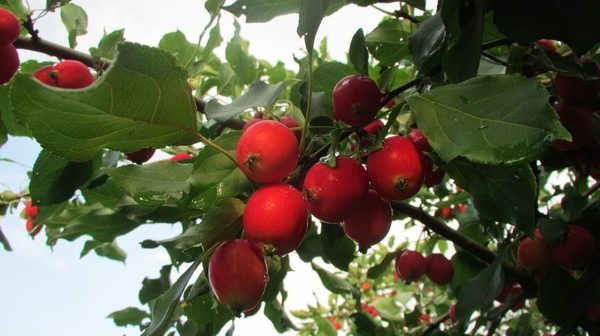
Advantages and disadvantages
The undoubted advantages of apple-growers:
- high winter hardiness
- lack of care,
- good storage and processing of fruits,
- opportunity to grow in the northern climatic zone,
- friendly and abundant yield of the crop.
The disadvantages include:
- small and medium fruits, their sour taste,
- frequent damage by pests and diseases
- large trees with a large crown, requiring a lot of space.
Terms of ripening and harvesting
The fruits ripen, as mentioned above, in late August, September. Productivity is usually high: 50-100kg. from a grown tree. Frost does not affect yield.
There are varieties that periodically bear fruit: their yield is in a year. Trees are durable and can bear fruit for decades. Minor ranethes (dicky) as a rule, do not collect. After the early frosts, children and birds enjoy them.
Rules for planting apple trees
Ranetka is a plant for "lazy" gardeners. They are not demanding on the fertility of the soil, therefore fertilizer should be applied to the pit only ifif the earth is not pure sand or clay. Prefer loamy soil, although fertile soil is preferred for any plant. A young woman can grow in light shading, so the place can be chosen is not the sunniest. And it does not matter whether there will be snow here in the winter. Ranetka - frost-resistant culture.
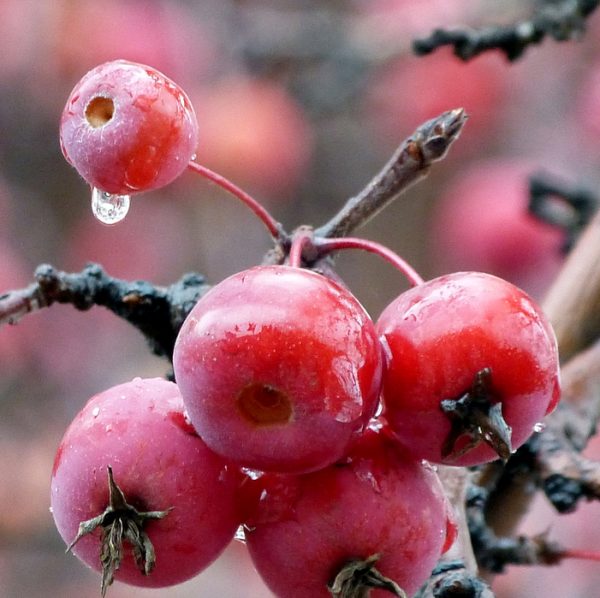
Plants are planted in early spring before the start of sap flow or in the fall so that the seedling will take root before the start of frost. It is necessary to correctly distribute the area between the trees: for strong-growing - 5 to 5 m., For medium-growth 4 to 4 m. Soil waters should not come close to the surface. The pit is prepared in advance. They dig up the bottom, fill it with a fertile layer of soil by 1/3. Fertilizers are added, a column is instilled in the middle to which the young plant is attached.
The seedling is planted so that the root neck is slightly raised above the ground. The earth is poured and nailed, watered with 2 buckets of water. Pristvolny circle mulch. Apple tied up, and now she is ready to grow and delight their masters.
Features of care for apples ranet
Further work is as follows:
- feeding the root system and watering,
- prevention against pests and diseases
- make sure that the trunk circle is loose and clear of weeds,
- spring thin out old, frozen branches and growing in the middle,
- in the spring, the trunk is whitened with lime, and in the winter it is wrapped in rags from rodents.
The crown needs to form and care for the tree regularly, otherwise it will run wild, will lose appearance and will not bring the expected yields.
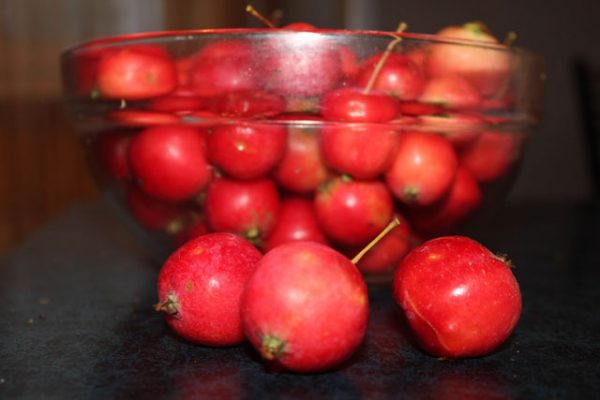
Diseases and pests
They have a large number of apple. Therefore, we will focus on preventive measures. The first spraying is carried out before the start of sap flow (700 g of urea is dissolved in 10 liters of water). So all wintering pests perish. You can use biological products from migratory pests 1 time per month.
Simultaneously spray solutions that increase the resistance of trees to disease and adverse weather conditions.
Basic rules for processing trees:
- spraying bordeaux in summer. In the summer, it can burn the leaves, so do a test first, and if everything is in order, then proceed,
- if there are cracks in the trees, then they are treated with 1% copper sulfate solution, rubbed with fresh leaves of sorrel and close up with garden pitch,
- trapping belts made of corrugated paper do not allow pests to creep along the trunk,
- the cloth, lay around the booster from a non-drying layer of glue, makes it easy to catch the pest.
These simple tricks will greatly facilitate your work and help the tree stay healthy.
Ranet apples are our northern wealth. A gift that gives us the opportunity not only to admire the beautiful trees, but also to feel like real gardeners. Harvest and savor such healthy fruits with northern sourness.
And finally, a small video in which you will learn what can be prepared from the ratings:
